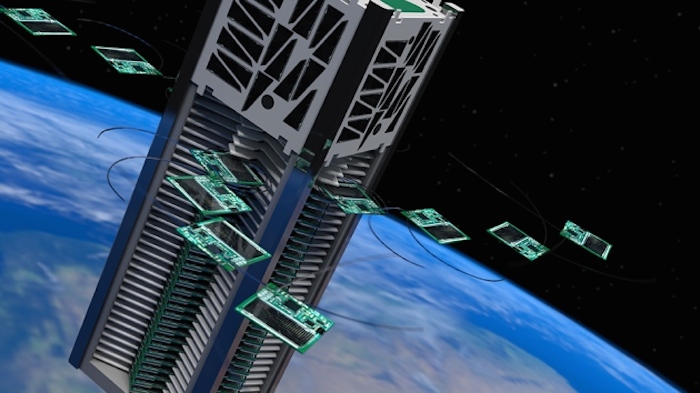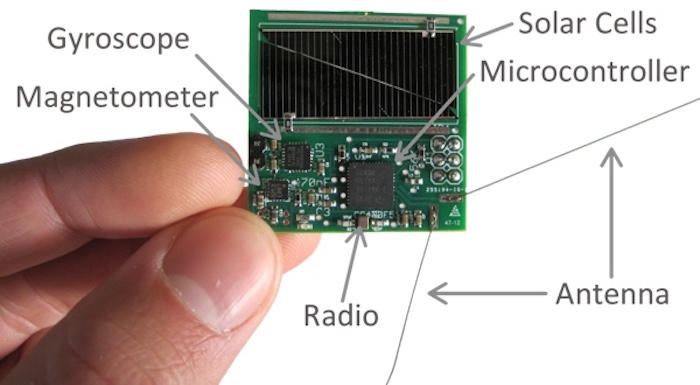.

KickSat satellite (artist’s impression) will launch several minuscule chipsats.
-
On 6 July, if all goes to plan, a pack of about 100 sticky-note-sized ‘chipsats’ will be launched up to the International Space Station for a landmark deployment. During a brief few days of testing, the minuscule satellites will transmit data on their energy load and orientation before they drift out of orbit and burn up in Earth’s atmosphere.
The chipsats, flat squares that measure just 3.2 centimetres to a side and weigh about 5 grams apiece, were designed for a PhD project. Yet their upcoming test in space is a baby step for the much-publicized Breakthrough Starshot mission, an effort led by billionaire Yuri Milner to send tiny probes on an interstellar voyage.
“We’re extremely excited,” says Brett Streetman, an aerospace engineer at the non-profit Charles Stark Draper Laboratory in Cambridge, Massachusetts, who has investigated the feasibility of sending chipsats to Jupiter’s moon Europa. “This will give flight heritage to the chipsat platform and prove to people that they’re a real thing with real potential.”
The probes are the most diminutive members of a growing family of small satellites. Since 2003, researchers have launched hundreds of 10-centimetre-sided CubeSats — more than 120 last year alone. Engineer Jekan Thanga at Arizona State University in Tempe is now working on an even smaller ‘femtosatellite’, a 3-centimetre cube that he says has the technological capacity of the first CubeSats. Chipsats, which are smaller and cheaper still, are seen as disposable sensors that could be sent on suicide missions to explore hostile environments, such as Saturn’s rings.
“They’re all part of the toolbox for next-generation space missions,” says Thanga.
The upcoming chipsat test, called KickSat-2, is the second incarnation of a crowdfunded mission developed by researchers at Cornell University in Ithaca, New York. The shoebox-sized KickSat-1 spacecraft successfully launched on 18 April 2014, but it failed to deploy its cargo of 104 chipsats after a cosmic radiation burst reset the clock on its release mechanism. The craft fell out of orbit and burned up with the chipsats still in its hold.
“I was a little bummed out,” says Zachary Manchester, an aerospace engineer who built the satellites as a doctoral student in aerospace engineering at Cornell. Fortunately, enough spare parts were lying around to make a second batch relatively quickly and easily.
The chipsats, called Sprites, carry little more than a pair of 60-milliamp solar cells, a radio and an antenna. The KickSat-2 payload includes some newer Sprites that can ‘sail’ by tilting towards or away from the Sun. A current is run through a coil, turning the chip into a compass needle that aligns with Earth’s magnetic field, allowing the chipsat to control its orientation. The probes can be reprogrammed on the fly from the space station.
Sprite prototypes have already proved that they can survive the rigours of space. In 2011, three chipsats were attached to the outside of the space station. They were still working when scientists retrieved them in 2014.
That commercial electronics are good enough to survive space’s vacuum and extreme temperatures is a “pretty big deal”, says Mason Peck, an aerospace engineer who leads Cornell’s chipsat team. But on a flight into deep space, chipsat electronics would face a high risk of damage from radiation. “There are some clear paths to radiation hardening, but it’s expensive,” says Peck. “And that’s not the point. You don’t want to make an exquisite satellite. You just launch a million; if only 1% survive then that’s fine. You put statistics on your side.”
There is plenty of science that Sprites can do closer to home. Peck says that the tiny satellites could be used to verify models of how small bits of debris behave in the upper atmosphere. Like feathers on Earth, the small, flat objects would be heavily affected by drag. “We’re not very good at modelling that,” says Peck. Another potential project would be to use Sprites to make a high-spatial-resolution map of Earth’s magnetic field.
“That would be really useful,” agrees Jeffrey Love, a geophysicist with the US Geological Survey in Denver, Colorado, who studies Earth’s magnetism. “Ideally you’d want to be measuring it everywhere all the time. This could be a step in that direction.”
For the long-term interstellar goal, chipsats will need much better laser-communication capacity. That should be possible, say Peck and Manchester, who are both on the Breakthrough Starshot advisory committee.
“We have gone a long way towards proving we can have a functional tiny craft,” says Peck.
Quelle: nature
.
Update:
These Tiny Spacecraft Could Lead Us to Alpha Centauri
Earlier this spring, Russian billionaire Yuri Milner casually announced his intention to develop spacecraft that can travel at up to 20 percent the speed of light and reach Alpha Centauri within twenty years. From the outset, it was clear that no humans would be making the warp jump—the mission will involve extremely lightweight robotic spacecraft. A new fleet of tiny satellites hints at what those future interstellar voyagers will look like and be capable of.
Meet Sprites: sticky note-sized devices that sure look like the result of the Pentagon’s long-anticipated floppy disk purge, but are in fact state-of-the-art spacecraft complete with solar cells, a radio transceiver, and a tiny computer. Later this summer, a Cornell-led project called Kicksat-2 will launch 100 of these puppies to the International Space Station. There, the satellites will spend a few days field-testing their navigational hardware and communications systems before burning up in orbit.
The project’s lead engineers, Zachary Manchester and Mason Peck, are on the advisory committee for Breakthrough Starshot, an ambitious effort to reach our nearest neighboring star system within a generation. (In fact, the potato chip-sized computer Milner held up during a highly publicized press conference in April was Manchester’s own design.) Sprites, and the “chipsat” technology they’re based on, are a step toward that goal of interstellar travel. More generally, they’re an indication of the future of space exploration.
“A chipsat is never going to replace a big [spacecraft], but it can do exciting new things like land on a planet,” said Brett Streetman, an aerospace engineer with the Cambridge-based nonprofit Draper, which has been developing chipsat technology since 2007. “We imagine sending them to places where you wouldn’t want to risk sending your normal spacecraft, or leveraging the physics of getting that small.”
Advantages of being very small and lightweight include the ability reach very high, even relativistic speeds, shaving years off the time it takes to get around the solar system. Combine speed with the inherent disposability of the technology, and you’ve got a cost-effective option for dive-bombing into the plume of Saturn’s moon Enceladus, attempting risky landings on comets, or sailing out of the solar system and beaming information back.
That, at least, is the idea. First, the technology needs to be proven in orbit. In 2011, three of the Manchester’s first-generation Sprites were strapped to the outside of the ISS and left to soak up a hefty dose of radiation. Encouragingly, the off-the-shelf hardware was still functioning when astronauts retrieved the devices several years later.
In April 2014, Kicksat-1 was launched into orbit in what was intended to be the technology’s first large-scale field test. Unfortunately, after being walloped by a burst of cosmic radiation, the Kicksat-1 container (the thing that looks suspiciously like a CD-ROM tower in the video above) failed to deploy its cargo of 104 Sprites, which fell back into our atmosphere and were destroyed.
With the crowdfunded Kicksat-2, Manchester and his collaborators are trying again. Their payload, which is slated to launch on an upcoming resupply mission to the ISS, represents the largest number of satellites ever to be deployed at a single time.
“We’re trying to run a mission with 100 tiny satellites,” Manchester told Gizmodo. A key goal will be to test the Sprites’ communications system, which relies on a protocol called code division multiple access (CDMA)—the same method that a cellphone tower uses to talk to hundreds of individual devices over the same radio bandwidth. Being able to talk with individual Sprites in this manner is a critical step toward to tracking swarms of little spacecraft on a deep space mission.
.

A chipsat. Image: Zac Manchester
Some of the Sprites on Kicksat-2 also include a tiny loop of wire that generates a small magnetic field when a current is passed through it. “This basically turns the entire satellite into a compass needle, allowing you to align it with Earth’s magnetic field for steering,” Manchester said.
We’re still years out from a fleet of spacecraft that are truly capable of pulling off an interstellar voyage. Manchester’s Sprites weigh just four grams, but eventually, Breakthrough Starshot hopes to scale its satellites down to a quarter that size. “The smaller you can shrink the satellite, the less gigantic the laser [propulsion system] has to be,” Manchester said.
For a trip to Alpha Centauri, there are also major technological hurdles to be overcome in terms of power storage and long-distance communication. Still, it’s encouraging to see that researchers are already thinking about how we can engineer the cheaper, smaller, and faster technology that’ll eventually allow us to reach new distances and speeds. So, in the interest of one day landing on Europa and crossing the edge of the Oort cloud, here’s hoping that box of high-tech floppy drives has a smooth launch.
Quelle: GIZMODO
5454 Views
